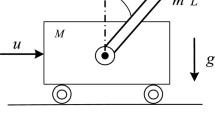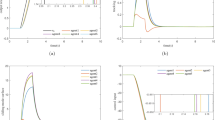Abstract
This paper presents a robust adaptive boundary layer thickness (BLT) of sliding mode control (SMC) for a secure communication of chaos-based system. First, chaotic system was remodeled into the Takagi–Sugeno (T-S) fuzzy format. Second, a novel SMC with an adaptive finite time reaching phase and an adaptive BLT of fixed time sliding phase was proposed to synchronize the master and slave systems (MSSs). The matched disturbances on three channels of the secure communication system (SCS) were rejected by the proposed method. To prove that the proposed theories are corrected, the Lyapunov condition was used to meet the goal. Furthermore, the simulation study was used to verify the correction and effectiveness of the proposed algorithm. The tracking errors and reaching times are very small. The sent and received data were precisely tracked each other in the short time.








Similar content being viewed by others
References
Chang, D., Li, Z., Wang, M., & Zeng, Y. (2018). A novel digital programma-ble multi-scroll chaotic system and its application in FPGA-based audio secure communication. AEU-International Journal of Electronics and Communications, 88, 20–29.
Chen, Y. J., Chou, H. G., Wang, W. J., Tsai, S. H., Tanaka, K., Wang, H. O., & Wang, K. C. (2020). A polynomial-fuzzy-model-based synchroniza-tion methodology for the multi-scroll Chen chaotic secure communica-tion system. Engineering Applications of Artificial Intelligence, 87, 103251.
Çiçek, S., Kocamaz, U. E., & UyaroÄÿlu, Y. (2018). Secure communication with a chaotic system owning logic element. AEU-International Journal of Electronics and Communications, 88, 52–62.
Ding, S., & Wang, Z. (2020). Synchronization of coupled neural networks via an event-dependent intermittent pinning control. IEEE Transactions on Systems, Man, and Cybernetics: Systems, 52(3), 1928–1934.
Esfahani, S. H. (2020). Further improvements on the problem of optimal fuzzy H tracking control design for T-S fuzzy systems. Journal of Control, Automation and Electrical Systems, 31(4), 874–884.
Fuh, C. C. (2008). Variable-thickness boundary layers for sliding mode control. Journal of Marine Science and Technology, 16(4), 7.
Giap, V. N., & Huang, S. C. (2020). Effectiveness of fuzzy sliding mode control boundary layer based on uncertainty and disturbance compensator on suspension active magnetic bearing system. Measurement and Control, 53(5–6), 934–942.
Giap, V. N., Huang, S. C., Nguyen, Q. D., & Su, T. J. (2020). Disturbance observer-based linear matrix inequality for the synchronization of Takagi-Sugeno fuzzy chaotic systems. IEEE Access, 8, 225805–225821.
Giap, V. N., Huang, S. C., & Nguyen, Q. D. (2020b). Synchronization of 3D chaotic system based on sliding mode control: Electronic circuit implementation. In 2020 IEEE Eurasia Conference on IOT, Communication and Engineering (ECICE) (pp. 156–159). IEEE.
Giap, V. N., Vu, H. S., Nguyen, Q. D., & Huang, S. C. (2021). Disturbance and uncertainty rejection-based on fixed-time sliding-mode control for the secure communication of chaotic systems. IEEE Access, 9, 133663–133685.
Giap, V. N., Nguyen, Q. D., & Huang, S. C. (2021). Synthetic adaptive fuzzy disturbance observer and sliding-mode control for chaos-based secure communication systems. IEEE Access, 9, 23907–23928.
Giap, V. N., Huang, S. C., Nguyen, Q. D., & Su, T. J. (2021). Robust control-based disturbance observer and optimal states feedback for T-S fuzzy systems. Journal of Low Frequency Noise, Vibration and Active Control, 40(3), 1509–1525.
Giap, V. N., Vu, H. S., Nguyen, Q. D., & Huang, S. C. (2021). Robust observer based on fixed-time sliding mode control of position/velocity for a TS fuzzy MEMS gyroscope. IEEE Access, 9, 96390–96403.
Lai, Q., Norouzi, B., & Liu, F. (2018). Dynamic analysis, circuit realization, control design and image encryption application of an extended Lü system with coexisting attractors. Chaos, Solitons & Fractals, 114, 230–245.
Lendek, Z., Guerra, T. M., Babuska, R., & De Schutter, B. (2011). Stability analysis and nonlinear observer design using Takagi-Sugeno fuzzy models (Vol. 262). Springer.
Li, W., Bai, G., & Imani Marrani, H. (2020). A new robust finite-time synchronization and anti-synchronization method for uncertain chaotic systems by using adaptive estimator and terminal sliding mode approaches. Journal of Control, Automation and Electrical Systems, 31(6), 1375–1385.
Lin, H., Wang, C., & Tan, Y. (2020). Hidden extreme multistability with hyperchaos and transient chaos in a Hopfield neural network affected by electromagnetic radiation. Nonlinear Dynamics, 99(3), 2369–2386.
Liu, P., Zeng, Z., & Wang, J. (2018). Global synchronization of coupled fractional-order recurrent neural networks. IEEE Transactions on Neural Networks and Learning Systems, 30(8), 2358–2368.
Luo, H., & Zheng, J. (2021). Dissipativity-based fuzzy integral sliding mode control of nonlinear stochastic systems. Discrete Dynamics in Nature and Society.
Mofid, O., Momeni, M., Mobayen, S., & Fekih, A. (2021). A disturbance-observer-based sliding mode control for the robust synchronization of uncertain delayed chaotic systems: Application to data security. IEEE Access, 9, 16546–16555.
Naderi, B., Kheiri, H., Heydari, A., & Mahini, R. (2016). Optimal synchronization of complex chaotic t-systems and its application in secure communication. Journal of Control, Automation and Electrical Systems, 27(4), 379–390.
Nguyen, Q. D., Nguyen, H. P., Vo, D. N., Nguyen, X. B., Ueno, S., Huang, S. C., & Giap, V. N. (2022). Robust sliding mode control-based a novel super-twisting disturbance observer and fixed-time state observer for slotless-self bearing motor system. IEEE Access, 10, 23980–23994.
Polyakov, A. (2011). Nonlinear feedback design for fixed-time stabilization of linear control systems. IEEE Transactions on Automatic Control, 57(8), 2106–2110.
Rybin, V., Tutueva, A., Karimov, T., Kolev, G., Butusov, D., & Rodionova, E. (2021). Optimizing the synchronization parameters in adaptive models of Rössler system. In 2021 10th Mediterranean Conference on Embedded Computing (MECO) (pp. 1–4). IEEE.
Shi, S., Gu, J., Xu, S., & Min, H. (2019). Globally fixed-time high-order sliding mode control for new sliding mode systems subject to mismatched terms and its application. IEEE Transactions on Industrial Electronics, 67(12), 10776–10786.
Sun, J., Yi, J., Pu, Z., & Tan, X. (2018). Fixed-time sliding mode disturbance observer-based nonsmooth backstepping control for hypersonic vehicles. IEEE Transactions on Systems, Man, and Cybernetics: Systems, 50(11), 4377–4386.
Sun, X., & Zhang, Q. (2018). Observer-based adaptive sliding mode control for T-S fuzzy singular systems. IEEE Transactions on Systems, Man, and Cybernetics: Systems, 50(11), 4438–4446.
Takagi, T., & Sugeno, M. (1985). Fuzzy identification of systems and its applications to modeling and control. IEEE Transactions on Systems, Man, and Cybernetics, 1, 116–132.
Tian, Y., Cai, Y., & Deng, Y. (2020). A fast nonsingular terminal sliding mode control method for nonlinear systems with fixed-time stability guarantees. IEEE Access, 8, 60444–60454.
Utkin, V. (1977). Variable structure systems with sliding modes. IEEE Transactions on Automatic Control, 22(2), 212–222.
Wang, J. L., Qin, Z., Wu, H. N., & Huang, T. (2018). Passivity and synchronization of coupled uncertain reaction-diffusion neural networks with multiple time delays. IEEE Transactions on Neural Networks and Learning Systems, 30(8), 2434–2448.
Wang, X., & Gao, S. (2020). Image encryption algorithm for synchronously updating Boolean networks based on matrix semi-tensor product theory. Information Sciences, 507, 16–36.
Wang, L., Zeng, Z., & Ge, M. F. (2019). A disturbance rejection framework for finite-time and fixed-time stabilization of delayed memristive neural networks. IEEE Transactions on Systems, Man, and Cybernetics: Systems, 51(2), 905–915.
Wang, X., Park, J. H., Yang, H., Zhang, X., & Zhong, S. (2019). Delay-dependent fuzzy sampled-data synchronization of T-S fuzzy complex networks with multiple couplings. IEEE Transactions on Fuzzy Systems, 28(1), 178–189.
Wu, S., Su, X., & Wang, K. (2020). Time-dependent global nonsingular fixed-time terminal sliding mode control-based speed tracking of permanent magnet synchronous motor. IEEE Access, 8, 186408–186420.
Wu, Z., Zhang, X., & Zhong, X. (2019). Generalized chaos synchronization circuit simulation and asymmetric image encryption. IEEE Access, 7, 37989–38008.
Yan, J. J., Yang, G. H., & Li, X. J. (2018). Adaptive fault-tolerant compensation control for T-S fuzzy systems with mismatched parameter uncertainties. IEEE Transactions on Systems, Man, and Cybernetics: Systems, 50(9), 3412–3423.
Zhang, Y. Q., Hao, J. L., & Wang, X. Y. (2020). An efficient image encryption scheme based on S-boxes and fractional-order differential logistic map. IEEE Access, 8, 54175–54188.
Zhao, Y., Lin, H., & Li, B. (2021). Sliding-mode clamping force control of electromechanical brake system based on enhanced reaching law. IEEE Access, 9, 19506–19515.
Zhong, G. Q., & Tang, W. K. (2002). Circuitry implementation and synchronization of Chen’s attractor. International Journal of Bifurcation and Chaos, 12(06), 1423–1427.
Zhou, M., & Wang, C. (2020). A novel image encryption scheme based on conservative hyperchaotic system and closed-loop diffusion between blocks. Signal Processing, 171, 107484.
Funding
This research is funded by Hanoi University of Science and Technology (HUST) under project number T2022-TT-011
Author information
Authors and Affiliations
Corresponding author
Ethics declarations
Conflicts of Interest
The author declares no conflict of interest.
Additional information
Publisher's Note
Springer Nature remains neutral with regard to jurisdictional claims in published maps and institutional affiliations.
Appendix
Appendix
Proof of Lemma 2
In Tian et al. (2020), the Lyapunov condition should be selected as below.
If \(V(\sigma )=0\) is a special case. If \(V(\sigma )\ne 0\), we have \(\square \)
Case 1: \(\mid \sigma (t)\mid \ge 1\) Giap et al. (2021a)
Case 2: If \(\mid \sigma (t)\mid <1\), the settling time is limited as
Proof
The Lyapunov candidate once again should be selected as follows:
or
Taking integration for both side of (33) yields
or
or
Since \(\mid \gamma (0)\mid <1,\) it leads to
The stability of fixed time for (3) was proved as (30) and (37).
The operation of T-S fuzzy modeling of Lendek et al. (2011) is slightly written as below.
where g, h, and l are the smooth functions. y is output vector. The scheduling \(\chi _j \in [\chi _{min};\chi _{max}]\) where \(j \in [1,..,p].\) The weighting function is
The fuzzy membership is
where \(\varphi _ij\) is either \(n^j_0(.)\) or \(n^j_1(.)\) Using these concepts, system (7) becomes
\(\square \)
Rights and permissions
Springer Nature or its licensor (e.g. a society or other partner) holds exclusive rights to this article under a publishing agreement with the author(s) or other rightsholder(s); author self-archiving of the accepted manuscript version of this article is solely governed by the terms of such publishing agreement and applicable law.
About this article
Cite this article
Nguyen, Q.D., Huang, SC. & Giap, V.N. Robust Adaptive Terminal Fixed Time Sliding-Mode Control for a Secure Communication of T-S Fuzzy Systems. J Control Autom Electr Syst 34, 507–518 (2023). https://doi.org/10.1007/s40313-023-00991-w
Received:
Revised:
Accepted:
Published:
Issue Date:
DOI: https://doi.org/10.1007/s40313-023-00991-w




